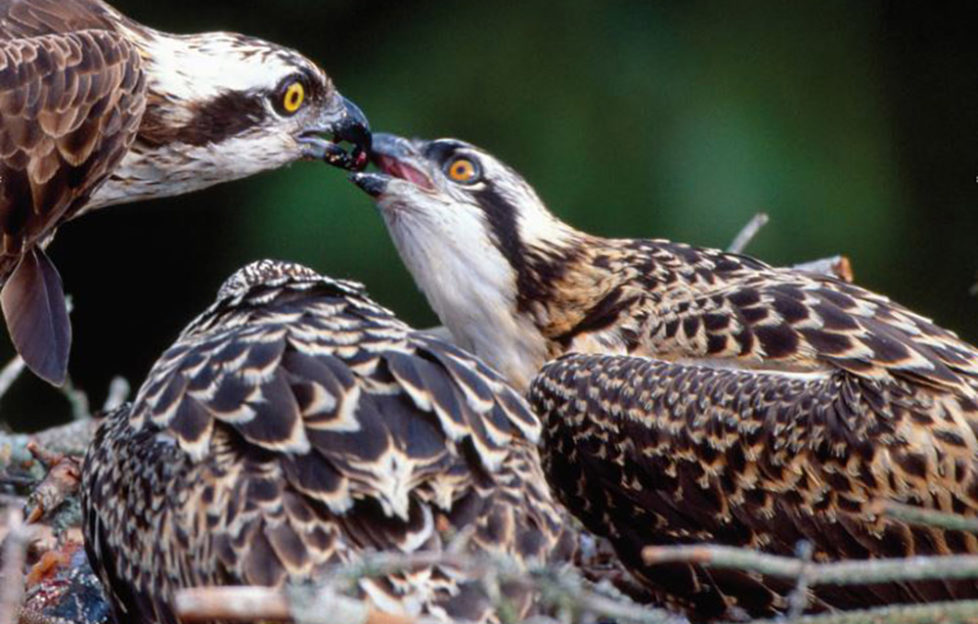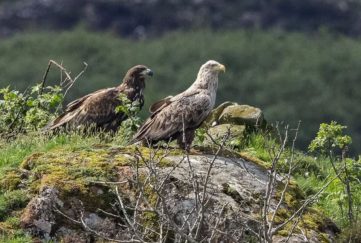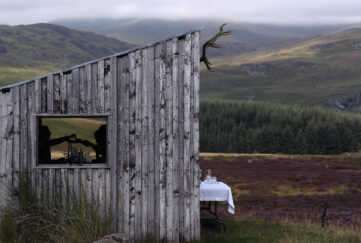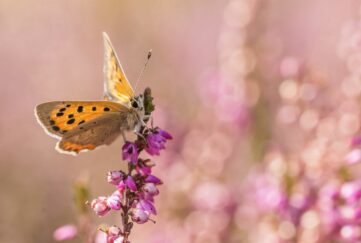Protecting A Pioneer – Jim Crumley

 Jim recallsprotecting the first osprey nest in Stirlingshire armed only with a torch and loud-hailer – and being rewarded with many magical sights…
Jim recallsprotecting the first osprey nest in Stirlingshire armed only with a torch and loud-hailer – and being rewarded with many magical sights…
THE nest we were protecting was on the top of a dead tree. A dead tree trunk to be more precise, for it had long since lost its canopy and limbs. All that was still rooted in the earth was a trunk of considerable girth but no more than about 15 feet in height, for it had been broken apart two years before by a gale.
But what was left was jagged enough and wide enough to persuade a pair of ospreys to anchor a nest there. It was in the middle of a wood but the wood was young, and for the time being the old tree offered enough of a look-out for the ospreys’ needs, for they like to be able to see what’s coming in every direction.
The trouble was egg thieves. Ospreys were still relatively new on the face of the land, and furth of Speyside at least, their presence was sporadic and tentative at best. And this was Stirlingshire, the edge of the Trossachs, a well-trod land with good lochs and plenty of fish. On the face of it, they could do well here. But a 15-foot-high tree with a three-foot-deep nest on top only needs a 20-foot-long ladder. And osprey eggs back then were worth a lot of money.

Pic credit: L. Campbell
I became a regular through-the-night sentry of an organised watch on the eyrie. It was an exhilarating crash course in osprey ecology, for until then, hardly any of us had seen one.
The technology at our disposal was on the low-tech side of primitive. To call for back-up we had walkie-talkie radios, linked to a house a mile away where the where the organiser lived and where there was a telephone. And if the radios worked and the organiser heard them at 2am and woke and phoned the police in Aberfoyle, and if the police were in the station and not out fighting what they considered to be more serious crime, then it was just possible they could be at the edge of the wood in about 15 minutes, somewhere near the eyrie tree. It wasn’t easy to find in the dark, though – in perhaps half an hour after the call was made they’d be here. Perhaps an hour… perhaps not at all…
There was also deterrent technology. This consisted of a very large torch and a loud-hailer. We had to shout discouraging slogans. We could not pretend to be police, there are laws against that. We were also not permitted to intervene physically – although if push came to shove, one or two among our number would not have stood by while a clutch of osprey eggs disappeared into the night.
Protecting The Osprey By Night Watch
We watched in pairs. One off-duty, one on, a couple of hours at a time. There was a very un-waterproof tent in which, theoretically, the off-duty one slept. Such was the front line in the war against egg thieves in the dark ages.
We repulsed one attempt, or at least we think we did. There were voices near the eyrie, we deployed the flashlight and the loud-hailer, the voices fell silent. We shone the light on the eyrie and the head of the sitting bird glared back.
The relief when daylight touched the tree and she was still there, still sitting tight… it revisits me now after more than 40 years. When the birds eventually abandoned that nest two or three years later, they took to a vast larch tree. This eyrie, again right in the topmost thrust of the tree, must have moved eight feet across the sky in a big wind.
These were the first ospreys to nest beyond Speyside, pioneers of a population that thrives in the Trossachs now, and every spring the return of the first ospreys to the upper reaches of the Forth still puts a lump in my throat. I remember again the smell of the tent, the weight of the flashlight and that tension-packed moment when I switched on the loud-hailer.
One more moment, as indelible as the morning after that particular night before, returns with vividness undimmed. It was of the same bird, the original female on that storm-broken tree, on a different early morning. I was watching her on the eyrie through binoculars. She was settled deep into it so that only her white head showed, then suddenly she was touched by the sunrise. Within seconds she was up on the rim of the nest, stood to her full height and opened her wings. She beat them perhaps five or six times and a cascade of dew curved up into the air, caught the sunlight so that every droplet glowed deep orange, then fell in a curve of technicolor rain. Then she stowed her wings, preened vigorously, settled again and the thing was done.
But of course, the thing was not done – witness the fact that it still springs to the front of my mind at the least provocation after all these years.
A New Fascination
So that was the beginning of my fascination for ospreys. The whole thing had to be kept secret – or as secret as humanly possible, for there is nothing covert about the way an osprey conducts its day-to-day life through one more spring’s nesting season.
Since then, the osprey has thrived in Scotland, and become an ambassador that has won friends for nature across the land. The years drift by, the osprey population consolidates, a handful have become celebrities and tourist attractions at known locations.

Pic credit: L. Campbell
Meanwhile, my own approach to them has evolved. I no longer sit on the same lochside every late spring, half a mile from that now decrepit tree. Instead, I check all the places I know they are likely to be whenever I happen to be there, and when I find a new one I fold it carefully into my personal anthology of osprey encounters.
But there would come an afternoon of high summer, drowsed in warmth, when I would return to that original landscape with only ospreys on my mind.
I borrowed a boat. I don’t fish, I watch the osprey fish. I cut the almost silent electric outboard and began rowing. After half a mile I let the boat drift and began to watch the sky, the edges of the trees, the loch’s surface and the airspace. It took 30 seconds to find the first osprey quartering the reedy shallows of the nearest shore. I nudged the boat that way with the oars, then let it drift again. Ospreys hereabouts are well accustomed to small boats, for the loch is stocked and every regular angler has stories about the ones that got away in osprey talons. But that blue, midweek afternoon the water was quiet.
A Spot Of Bird Watching
The bird patrols its chosen airspace in slow circles. Sunlight, direct from above and reflected from below, fires up the white head and breast and underwings, as brilliant as stained glass. It flips onto one wingtip, sets its wings into a tight “W” shape, and falls. A yard above the surface, it pulls out and back up into the very airspace it has just vacated, and resumes its patient circling.
Ten minutes and six dives later, it has still not breached the surface. The power and the beauty of it all…
A second osprey is directly over the drifting boat, looking down from the eye of the sun. With one hand raised against the sun, I see a bird rimmed in golden light. It flies on, and while I manhandle the boat through 90 degrees so that I can watch, there is a splash behind me.

Pic credit: Alamy
By the time my manoeuvre is complete the osprey is motionless on the surface, wings spread wide. Then it heaves its wings back with their leading edges pointing towards the sky, then forward so that the primaries almost touch several feet in front of its face, and as they part and heave back again, the bird lifts and begins to travel forward. As it clears the water, its lowered legs and bunched talons haul out a rainbow trout. It will die somewhere over the shoreline trees, which cannot be how a trout expects to die.
There were more ospreys: in the sky, perched on the outer edges of trees, calling from the shore in thin, reedy whistles, tipping over in mid-air to smash open the plate glass stillness of the surface, climbing again and again with and without fish and shimmying the water from their plumage in sun-starred cascades that effortlessly recalled the first of all my ospreys on her stunted tree.
Spotting 15 ospreys!
It was an intoxication. In three hours of rowing and drifting, I saw 15 ospreys. Some I may have seen more than once, but I had six in the sky at one time.
I rowed back to the shore feeling as if I had strayed into a parallel realm of nature where different laws held sway. When I stepped back on to land and looked back at the water I was already apart from it.
For a while I had borrowed from the birds, from the water, from nature; I had been allowed a glimpse of something extraordinary, but my time was up.
Even now, writing it down and passing it on feels like a kind of betrayal. What do I really know of what I saw? What part of my limited understanding of what it is to be an osprey is enriched? I still don’t know.
It has been 60 years since that milestone on the Scottish osprey’s long road to repatriation that is the celebrated return to Loch Garten on Speyside. But only the osprey watcher marks such an anniversary. The osprey itself marks only the turn of the wild year, one more step on the long march back from the rim of extinction, a march that lasts forever. The least I can do is try to keep in step. Meanwhile, I still don’t fish, and I still watch the osprey fish because I love poetry and watching the osprey fish is watching poetry in motion.
You can read more of Jim Crumley’s Scottish wildlife columns online here, and each month in The Scots Magazine.
Subscribe to The Scots Magazine today for more from Jim Crumely >>





